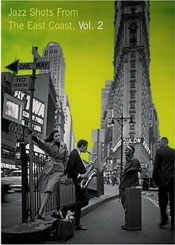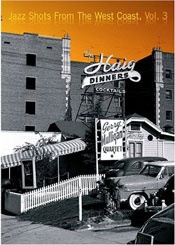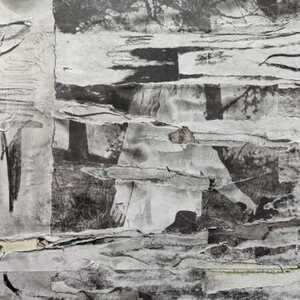
Jazz Shots From the East Coast, Volumes 2 and 3
Jazz Shots From the West Coast, Volumes 2 and 3
MVD Visual

The volume of classic jazz performances available in visual form continues to increase, 40 years after much of the stuff was recorded. In all cases such developments have proven welcome to fans and scholars of the music. MVD Visual teamed with Disconforme to add its share to the documentation, including an August release of four new DVDs that highlight some of the music’s leading lights, and some lesser-known artists. Truly, there is something for everyone, be ye hep cat or moldy fig.
The series is categorized along coastal lines, divisions that can be as instructive as they are misleading. The “East Coast” and “West Coast” series are more or less accurate, as far as geography goes; in that sense, the usual insinuations about stylistic differences are on display. The racial divisions also associated with the coasts show up in the series, where the black band leaders turn up on the East Coast series and the whites on the West, with a handful of exceptions on each side (Jim Hall, Woody Herman, Wes Montgomery, Lester Young). This doesn’t quite get across that most of these guys worked regularly on both coasts, though of course all the studios and offices were concentrated along the coasts.
Of all four volumes out now, Volume 2 of the East Coast set is probably the best single volume for the novice, or as a gift for someone whose tastes are unclear. There are several of the names most commonly identified with the idiom: Louis Armstrong, Count Basie, Miles Davis. EC2 has the only known footage of Charlie Parker, playing “Hot House,” as well as what might be the only clip of piano genius Art Tatum.
It begins on a perfect note: “So What,” the last of the great Miles/Coltrane collaborations. Next, Art Blakey’s early 1980s band with the Marsalis brothers, then a throwback to Parker and Gillespie, snarling through a quick take of “Hothouse.” Louis Armstrong’s 1950s “All Star” group play two, including his theme “When It’s Sleepy Time Down South.” The Modern Jazz Quartet effects transition to Ben Webster, paired with three young white cats who might have been toddlers when he first went over, tear through the song he owned during his Ellington run, “Cottontail.” Another quartet tune, “Chelsea Bridge” leads into the Webster sextet (including Basie’s old drummer, “Papa” Jo Jones) playing “C-Jam Blues” (titled incorrectly as “Duke’s Place”). Ellington’s influence persists. After the Farmer-Hall quartet, Count Basie drops “Dickie’s Dream.” After that, a Tatum clip pulled from some movie, then Bobby Hackett.
Volume 3 opens with two from John Coltrane, “Alabama” and “Afro Blue,” then the Blakey band returns, fronted by Wynton Marsalis. Gillespie brings his own band up next, playing “Blues After Dark” and a swinging “Lorraine” (named after his wife). The Thad Jones-Mel Lewis Orchestra – which, renamed the Village Vanguard Orchestra, has outlasted its founders by 20 years – adds an arrangement of “St. Louis Blues” that runs 12 minutes, but feels like five. Who else could follow that, but Jimmy Smith? Woody Herman’s band takes two, followed by the visionary quartet of Sonny Rollins and Jim Hall playing “God Bless the Child.” Pony Poindexter ends the disc, but not before two very different kinds of big-bands: the Miles-Gil Evans group takes three, followed by the Duke himself in what might be Newport ‘56 footage, ending with the lesser-known multi-instrumentalist Pony Poindexter. West Coast, Vol. 2 starts with three from Wes Montgomery, including “Round Midnight” and two from the Gerry Mulligan Quartet. Shorty Rogers takes three before Paul Desmond’s 1960s quartet plays “Emily.” The great Lester Young, an inspiration for countless saxophonists, including Parker, gets in two before tenor man Teddy Edwards ends the disc with three tracks of his own. Easily the lightest of the four discs.

West Coast, Vol. 3 (my favorite of the four discs) begins with an adventurous version of “Take Five” showing off the bottomless well of creativity that sprung from the lungs of Paul Desmond, as well as the Joe Morello feature “Castillian Drums.” The real money clip is rare footage of the Jimmy Giuffre Trio playing “The Train and the River” – the song that begins the great Jazz on a Summer’s Day film. Three tracks by Stan Kenton lead into “Valse Hot” by the quartet of Jim Hall and Art Farmer, which is (under alternate leadership credits) the only group to show up on both the East Coast and West Coast collections. Guitarist Hall is also the one musician to appear on more performances (four) than any other across these four DVDs. Hampton Hawes rocks a track suit to play “Stella by Starlight,” and a triple-dose of the tragic trombonist Frank Rosolino, including a sporty version of Sarah Whitlock’s favorite jazz composition, “Well, You Needn’t.” Poignant.
Complaints? Sure. It’s easy to cherry-pick artists that one would have liked to see included somewhere in this set: Chet Baker, Gene Krupa, Lee Konitz, Charles Mingus, Monk, Max Roach. Maybe they’re saving all the vocal clips for a separate release. But better to give credit for the five hours of quality material they have included. Certainly this is a series that can continue on for volumes to come.
But the only real objection to be raised is the utter absence of any explanatory data- not dates, locations, personnel listings or other documentation of how these clips came to exist. If they are organized within volumes along any particular line (say, in chronological order), there’s no way to tell. The addition of a booklet summarizing the brilliant performances within would add more value to what is already a valuable set of high-quality music. Of course, guessing the details makes for a nice parlor game, but if there’s one thing jazz fans demand, it is context. On that count, the producers made no attempt to provide any at all, but it’s still worth having.












